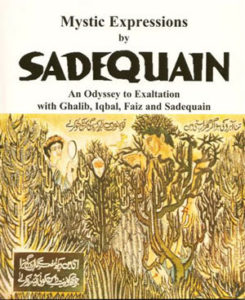Cataloguing a Genius
By Ilona Yusuf | Arts & Culture | Books | Published 14 years ago
 Launched at Gallery 6 in Islamabad at the end of 2010, Mystic Impressions and The Legend of Sadequain are two books that catalogue illustrations of poetic works by the artist. Both volumes are published in the United States by The Sadequain Foundation, a non-profit organisation which aims to preserve and promote the works of Sadequain. It is founded and run by a nephew of the artist, Dr Salman Ahmed, also the author of several articles in the volumes. To support its activities, the foundation reproduces Sadequain’s work in the form of giclee prints and hand-made carpets. Gallery 6, run by Dr Arjumand Faisal, who knew the artist personally, has been given the rights to market these items locally.
Launched at Gallery 6 in Islamabad at the end of 2010, Mystic Impressions and The Legend of Sadequain are two books that catalogue illustrations of poetic works by the artist. Both volumes are published in the United States by The Sadequain Foundation, a non-profit organisation which aims to preserve and promote the works of Sadequain. It is founded and run by a nephew of the artist, Dr Salman Ahmed, also the author of several articles in the volumes. To support its activities, the foundation reproduces Sadequain’s work in the form of giclee prints and hand-made carpets. Gallery 6, run by Dr Arjumand Faisal, who knew the artist personally, has been given the rights to market these items locally.
There have been prior publications documenting the work of the famous artist, notable among them The Holy Sinner. This comprehensive, luxurious volume curated by Salima Hashmi and Hameed Haroon was published several years ago under the aegis of the Mohatta Palace Museum. But such editions are often out of reach for the art enthusiast who doesn’t have much money. This is the market that the present books seem to target. They are fully illustrated, soft-cover editions printed on matte paper. Besides art work and poetry, they feature material on the artist: critical articles, biographical details, and photographic documentation.
In the case of Mystic Impressions, which features illustrations of poetry by Ghalib, Iqbal, Faiz and Sadequain, the layout of the book follows that of traditional art catalogues: the illustrated plate appears as a full page illustration, faced by the poetic verse written by the artist, followed by a Romanised transliteration, translation and prose annotation. The illustrations are well sized and the colours are reproduced fairly well, although because the paper used is not very heavy, they lack the luxurious quality of museum catalogues or coffee table books. What is usually found wanting in most translations is the music of the original, and the same holds true here. A new set of translations would have made the book a ground-breaking collection, with text and image complementing and enriching one other. Much work has been done recently in the field of translation, with new interpretations made using collaborations between poets and literal translators, in an effort to recreate the music of the original.
The Legend of Sadequain consists of the artist’s illustrations of his own poetry. The layout of this book is not as good as its companion volume, in which the reproductions are large and clear. Here, the overall impression is somewhat cluttered, and lacks crispness. It does contain, however, a considerable amount of reference material in the way of photographs from various periods of Sadequain’s life, as well as biographical articles and critiques of his work, some by family members and others by well-known critics.
Although the effort to reproduce so much valuable material is a step in the right direction with regard to preserving Sadequain’s prolific legacy for future generations, better attention to editing would have made the volumes far more readable. Students and art lovers will appreciate the sheer scope and quality of this virtuoso artist’s work, particularly since the volumes are only moderately expensive for individual buyers and will hopefully make their way into college libraries at some point. The reference material is a valuable asset for the latter, and absolutely necessary for a nation that suffers from a dearth of research tools. But for future editions (since the initial print run has already almost sold out), the editors might consider improving the language of the poetic works, making the volumes excellent as well as affordable.


